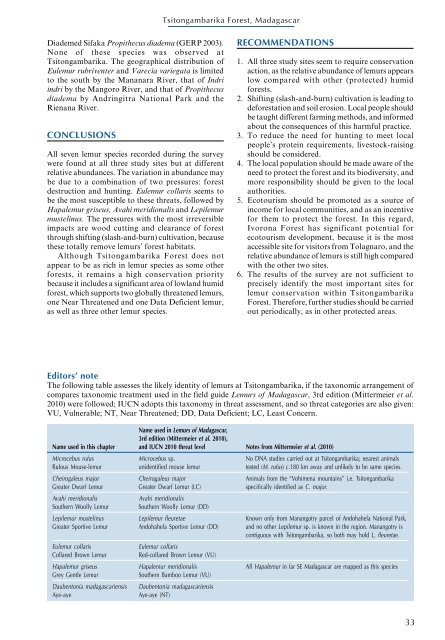TSITONGAMBARIKA FOREST, MADAGASCAR - BirdLife International
TSITONGAMBARIKA FOREST, MADAGASCAR - BirdLife International
TSITONGAMBARIKA FOREST, MADAGASCAR - BirdLife International
Create successful ePaper yourself
Turn your PDF publications into a flip-book with our unique Google optimized e-Paper software.
Diademed Sifaka Propithecus diadema (GERP 2003).<br />
None of these species was observed at<br />
Tsitongambarika. The geographical distribution of<br />
Eulemur rubriventer and Varecia variegata is limited<br />
to the south by the Mananara River, that of Indri<br />
indri by the Mangoro River, and that of Propithecus<br />
diadema by Andringitra National Park and the<br />
Rienana River.<br />
CONCLUSIONS<br />
All seven lemur species recorded during the survey<br />
were found at all three study sites but at different<br />
relative abundances. The variation in abundance may<br />
be due to a combination of two pressures: forest<br />
destruction and hunting. Eulemur collaris seems to<br />
be the most susceptible to these threats, followed by<br />
Hapalemur griseus, Avahi meridionalis and Lepilemur<br />
mustelinus. The pressures with the most irreversible<br />
impacts are wood cutting and clearance of forest<br />
through shifting (slash-and-burn) cultivation, because<br />
these totally remove lemurs’ forest habitats.<br />
Although Tsitongambarika Forest does not<br />
appear to be as rich in lemur species as some other<br />
forests, it remains a high conservation priority<br />
because it includes a significant area of lowland humid<br />
forest, which supports two globally threatened lemurs,<br />
one Near Threatened and one Data Deficient lemur,<br />
as well as three other lemur species.<br />
Tsitongambarika Forest, Madagascar<br />
RECOMMENDATIONS<br />
1. All three study sites seem to require conservation<br />
action, as the relative abundance of lemurs appears<br />
low compared with other (protected) humid<br />
forests.<br />
2. Shifting (slash-and-burn) cultivation is leading to<br />
deforestation and soil erosion. Local people should<br />
be taught different farming methods, and informed<br />
about the consequences of this harmful practice.<br />
3. To reduce the need for hunting to meet local<br />
people’s protein requirements, livestock-raising<br />
should be considered.<br />
4. The local population should be made aware of the<br />
need to protect the forest and its biodiversity, and<br />
more responsibility should be given to the local<br />
authorities.<br />
5. Ecotourism should be promoted as a source of<br />
income for local communities, and as an incentive<br />
for them to protect the forest. In this regard,<br />
Ivorona Forest has significant potential for<br />
ecotourism development, because it is the most<br />
accessible site for visitors from Tolagnaro, and the<br />
relative abundance of lemurs is still high compared<br />
with the other two sites.<br />
6. The results of the survey are not sufficient to<br />
precisely identify the most important sites for<br />
lemur conservation within Tsitongambarika<br />
Forest. Therefore, further studies should be carried<br />
out periodically, as in other protected areas.<br />
Editors’ note<br />
The following table assesses the likely identity of lemurs at Tsitongambarika, if the taxonomic arrangement of<br />
compares taxonomic treatment used in the field guide Lemurs of Madagascar, 3rd edition (Mittermeier et al.<br />
2010) were followed; IUCN adopts this taxonomy in threat assessment, and so threat categories are also given:<br />
VU, Vulnerable; NT, Near Threatened; DD, Data Deficient; LC, Least Concern.<br />
Name used in this chapter<br />
Name used in Lemurs of Madagascar,<br />
3rd edition (Mittermeier et al. 2010),<br />
and IUCN 2010 threat level Notes from Mittermeier et al. (2010)<br />
Microcebus rufus Microcebus sp. No DNA studies carried out at Tsitongambarika; nearest animals<br />
Rufous Mouse-lemur unidentified mouse lemur tested (M. rufus) c.180 km away and unlikely to be same species.<br />
Cheirogaleus major Cheirogaleus major Animals from the “Vohimena mountains” i.e. Tsitongambarika<br />
Greater Dwarf Lemur Greater Dwarf Lemur (LC) specifically identified as C. major.<br />
Avahi meridionalis Avahi meridionalis<br />
Southern Woolly Lemur Southern Woolly Lemur (DD)<br />
Lepilemur mustelinus Lepilemur fleuretae Known only from Manangotry parcel of Andohahela National Park,<br />
Greater Sportive Lemur Andohahela Sportive Lemur (DD) and no other Lepilemur sp. is known in the region. Manangotry is<br />
contiguous with Tsitongambarika, so both may hold L. fleuretae.<br />
Eulemur collaris Eulemur collaris<br />
Collared Brown Lemur Red-collared Brown Lemur (VU)<br />
Hapalemur griseus Hapalemur meridionalis All Hapalemur in far SE Madagascar are mapped as this species<br />
Grey Gentle Lemur Southern Bamboo Lemur (VU)<br />
Daubentonia madagascariensis Daubentonia madagascariensis<br />
Aye-aye Aye-aye (NT)<br />
33

















